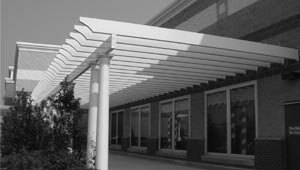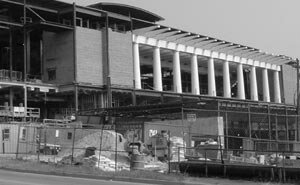Pergola pandemic: Sticking foolishness to the wall
If it's good enough for the Medici family, it's good enough for Charlottesville. Or is it? The new Target and the new John Paul Jones Arena have both adopted the pergola as an iconic statement. But it's funny how the same statement can mean different things.
The pergola is a structure that was conceived during the Renaissance to give order to an unwieldy garden. Pergolas are artificial canopies that provide some shelter and a matrix for woody plants to take hold. They're small-scale garden structures that facilitate natural (albeit structured) growth and unencumbered passage from one end to another. Despite this, our own pergola renaissance has reconstituted them in ways that are not entirely understandable.
Patrons of the new Target on 29 are greeted by several enormous pergolas tacked onto the side of what is essentially a brick box. Who are we kidding? It's a utilitarian structure– a brick-faced box. You park, you walk in, you shop, you leave. If a building is a box, then let it be a box. Adding some beveled white toothpicks to the façade is not going to heighten the "Target Experience," or make your box any more attractive. It just looks silly.
Target should have taken a cue from the work of SITE Environmental Design for the Best department stores. At least the designers for that now-defunct Virginia staple knew that "iconic" and "ironic" are eventual bedfellows.
Speaking of scale, it's hard to miss the new John Paul Jones Arena under construction on Emmet Street. But if you didn't know it was a new sports arena, you might think it was a Babylonian hanging garden. The massive pergola seems to be floating against a backdrop of terraced steel beams and brick.
According to Bob Moje of VMDO, the firm in charge of the JPJ Arena design, the pergola indicates the arena's principal entrance and is to be an iconic feature along Emmet. "The pergola encloses and is viewed from the interior of the seating bowl. The importance of this is that it gives the inside of the seating bowl, whether in person or on TV, an image or impression that is unique to The University of Virginia," Moje intones.
The pergola, in this situation, is both a framing device and a screen that reveals and conceals at the same time. What makes this pergola different from Target's is that it is set into an exterior wall– instead of hanging on for dear life outside the wall.
Moje's comments reflect the entertainment value of the arena as a building type. Entertainment Architecture has its own vocabulary in which scale and flash underwrite the design process. The JPJ Arena, one building type that is wholly part of Entertainment Architecture, is about experiential impact, human density, and visibility.
But pergolas are not part of that typology– they're not even close. Pergolas are small-scale garden follies that are inherently intimate. They exemplify a different kind of experience than an arena. Yes, a pergola that has been overrun by nature has visual impact– but passage through it is not about high visibility or human density at all. Passage through a pergola is about the human scale. While VMDO's logic is sound, their solution is questionable for its scale.
Looking for an iconic statement? A pergola on steroids works fine. Looking for a device to reveal and conceal simultaneously? Sure, a pergola will do that.
But pergolas are structures that either stand alone or are only minimally dependent on another structure. This may seem picky and slightly ridiculous. But for such a high-profile building– and such an iconic statement about Charlottesville for TV audiences (in Moje's words)– the architectural icing should fit the cake. Columns-in-antis, anyone?

Target's beveled white toothpicks
PHOTO BY WILLIAM RICHARDS

A Babylonian garden?
PHOTO BY WILLIAM RICHARDS